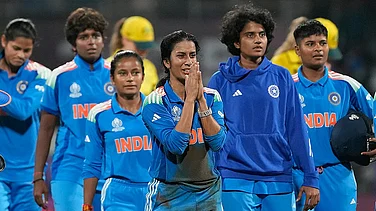Of all the important ideas that have convulsed the modern world, a good number have set forth from India and almost every one of them has washed up on its shores. The great English historian, E.P. Thompson, was absolutely right when he once wrote of India that "all the convergent influences of the world run through this society: Hindu, Moslem, Christian, secular; Stalinist, liberal, Maoist, democratic socialist, Gandhian. There is not a thought", Thompson concluded, "that is being thought in the West or East that is not active in some Indian mind". This motley intellectual flotsam has been picked up by Indians and turned by them to all sorts of uses-often to the surprise and chagrin of those who first cast these ideas into the world.
These ideas have fed conflicting visions of our society-sometimes they have impelled change and just as often they have obstructed it. The last millennium has been a series of struggles between clashing visions of the world. The contents of these conflicts have differed: they include struggles over whether some-kings, colonialists, religious majorities-can claim a natural or providential right to rule or whether all, at least in principle, should be free to rule; struggles over whether India ought to be a society rooted in hierarchy or one based on equality; and struggles over whether India should be a land of multiple or singular religious and cultural beliefs.
There are at least three ways of seeing this fading, turbulent millennium. The first two, common to older nationalisms of every hue, is to see it as a series of rude interruptions, of recurring invasions and dispossession-whether at the hands of Muslim gauchos or European adventurers, caste-carrying Aryan tribes or cigar-toting satellite TV moguls.
Devotees of Hindutva, for instance, see the past thousand years as a dark age, when the shiny innocence of antique Hindu ideas and practices was pawed over and soiled by crass ‘invaders’. Back in the golden, olden times, a self-sufficient, merrie India existed, innately tolerant, pious and where everyone knew their place. Then night descended. It began with the sorties of Mahmud of Ghazni, sweeping down from Central Asia, and continued: the anchoring at Calicut of the Sao Rafael, captained by Vasco da Gama; the fierce skirmishes on the fields of Panipat that heralded the beginning of Babur’s dynasty; the raising of Clive’s pennant at Plassey-all kept India in darkness. But a rosy, noisy dawn finally comes, with the end-of-millennium explosion of a nuclear bomb by a Hindu nationalist government.
It is not simple nostalgists alone who lull themselves with this story. Even a self-professed intellectual cosmopolitan and critic of mythography like, for instance, V.S. Naipaul can write in this vein, evoking India’s "own equivalent of the Dark Ages-after the Muslim invasions and the detailed, repeated vandalising of the North, the shifting empires, the 18th-century anarchy", and can choose to celebrate the restoration of India based on the idea of a gilded Hindu past.
A similar sense of victimhood, of being the inheritors of a wounded civilisation, runs through the conventional nationalist story of a ‘nation’ of authentic Indians coming into possession of their true inheritance. Here too, a tale of decline and revival is imposed on a past that in fact has been infinitely more contingent and open-ended. To imagine that India can be pushed or pulled into a cultural laager, where it can be healed and made whole-the handsome legend of Hindutva-is as self-deceiving as it was to have ever imagined that India could become entirely economically self-sufficient-the old nationalist tale.And, needless to say, the mirror image of such views, the globaloney of the Club Class set, which dreams of an India totally ‘integrated’ into a global economy and culture, is hardly any more convincing.
There is, though, another way of thinking about our past-not as a story of steady progress towards a mythic idea of self-identity but instead as a series of historical junctures and cultural coincidences. These have raised certain possibilities while also of course levying their own costs. Whether-and how-these possibilities have been taken up has depended on human decisions, actions and capacities-and never on any inevitable historical pressures or tendencies. In such a view of our past and present, the significant ideas that have shaped us would not be those that merely bolster a chosen story but rather those that open out possibilities. They would be ideas that have been susceptible to hijacking, to being turned to uses other than those for which they were intended: ideas, for instance, that may have been introduced to dominate and control but which in time were remade into contraptions for securing greater freedom. Therein lies the native cunning of the Indian past.
To look at it this way would be to see India as a cultural pinball machine. The hands releasing the springs have sometimes been hostile, the collisions-between protagonists unequal in their size and power-frequently bruising. But these encounters have struck up unique and splendid creations, cultural forms whose life and energy is drawn from the confrontational tension they embody. This view of the past extols the mongrel parentage of India’s peoples and their histories: instead of hankering for hermetic purity and safe pedigree, it finds in moments of intermixture the traces of the greatest creativity and imagination. And it insists that what was distinctive about India’s past was its ability to transmute marauders into residents, rupture into continuity, division into diversity.
From this perspective, the decisive ideas that have made India would all be ideas that have allowed Indians to make themselves-that encouraged us to reason for ourselves. And all are ideas that have, ultimately, forced open new lines of conversation and sociability between the many different individuals who inhabit the land, and that have made necessary the giving-and demanding-of justifications in public for our actions, beliefs and habits.
It is such practices that have fostered in us capacities to live together for periods of time in reasonable peace, despite profound differences. That we have shown an ability to do this for some periods in the past does not imply a necessarily cumulative process: there is no deep historical logic driving it-making us, for example, more moderate and tolerant. Human societies have to learn how to live in peace: the more they do it, the more practice they have at it, the better they get at it. But, unlike mastering how to ride a bicycle, this is a skill that it is all too easy to forget, to unlearn.
If there is any one idea that has done most to transform our possibilities, both as individuals and as a society, it is precisely a belief that our world-which once looked immovable and settled-is now up for grabs: that it can in fact be remade and refashioned, for better or worse. It is the idea of politics itself that has spread this belief-an idea that has electrified India over the past 100 years. To assign politics this pre-eminence in shaping India is not a judgement one can comfortably dine out with at the glittering socials of the materially more bloated in our society. The ubiquity of politics, its penetration into every cranny of Indian life, has of course spurred efforts to escape it.
Some succumb to a modish fantasy, current among the rich, that politics can be made to disappear. By languidly averting their gaze, by exercising their wrists on the channel-surfer or by lifting a choice canapŽ to their lips, by retreating into ever smaller encampments of self-regard-which they can parachute into and levitate out of-the urban rich take their soft pleasures through the hard business of consumption. They hope thus to flee politics. Others, revivalists, hope that the glue of religion can heal the fissures of politics. Still others, reformers, take refuge in the belief that the market can somehow shove politics aside: that it can by itself take what are fundamentally political decisions-decisions about priorities and allocations, about who gets what when. And some, romantics, place their faith in ‘civil society’, a grass-rooted verge beyond the shadow of politics. But for Indians there will be no politics-free zones-its grimy currents will pursue us well into the next century and beyond.
Two large ideas have shaped the entire world over the past 1,000 years: Christianity and Islam. These two religions, and the cultures they engendered, have dominated the millennium-their radial influence has extended across Africa, the Americas, and Asia. And both have made deep impresses on the Indian subcontinent.
The idea of Islam has shaped India in many ways. To recognise its deep millennial presence helps dispel hollow definitions of India as a Hindu country. Most palpably, Islam’s presence has defined the boundaries of independent India. But it would be wrong to succumb to the mirage of boundaries and to believe that their presence somehow means that Islam is external to India. It is not. It is integral to India, to any sense of what it has been, to what it is today, and most crucially, to what in the future it might possibly be.
Islam’s historical impress is strong. It is in the aesthetic crafts-in the making of visual, musical and architectural works-that we have shown our best talents over the past millennium. These are the domains in which, as a society, we have revealed to others and to ourselves something of what humans at their best are capable. And in all of these activities, it is quite impossible to imagine any of the major achievements without the presence-sometimes catalysing, sometimes defining-of Islam. From the development of a tradition of realist portraiture using the microscopic techniques that entered India from Persia, to the monumental tomb structures of the Mughals-set amidst innovative formal gardens and displaying the supreme grace of their domes (especially those that rest above the tombs of Mumtaz and Humayun)-and onwards to the classical Hindi cinema-at once nostalgist and progressivist-the creative presence of Islam has been fundamental.
But perhaps most importantly, Islam introduced into the Indian land the idea that the members of a spiritual or religious community could live together on an equal footing. This was an idea quite alien to the Hindu religions, committed as they were to the strict internal ghettos of caste. Islam’s idea of equality was of course far from being a symmetrical one-it discriminated against non-believers and most of all against women members of the community. But it did offer an image of equality that has resonated across the centuries.
This idea of a community of equals, subject to one religious law, took root in different ways. Around 500 years ago, for instance, it struck a chord among the inhabitants of the upper Doab-and stimulated the rise of Sikhism, another central idea that shaped India. The Sikh religion embodies a potent reformist impulse in Indian society, which has sporadically impressed itself upon the course of Indian history. Other important expressions of these were the emergence of the popular devotional Bhakti movements, Sufism, as well as, in this century, the anti-caste movements of Ambedkar, Ramaswamy Naicker and their followers.
The Sikh faith is the youngest of India’s many religions-and the only one to have been born here during the last millennium. It arose in large part as a response to the confrontations, often violent, between Muslims and Hindus that swirled across the Lahore hinterland, where its first teacher, Guru Nanak, was raised. The peace-loving doctrine he preached was a rejection (rather than synthesis) of aspects of the religions he felt caught between: Hinduism and Islam. He was against the idea of a God with a physical form and the superstitious rituals it promoted, against the taboos of caste, and against the fanaticism that produced violence. Although Sikhism is often described as an outgrowth of Hinduism, in fact its emergence would have been unlikely without the incitement of Islam.
Likewise, another basic idea that shaped India was also a consequence of Islam’s permanent settlement in the subcontinent. Islam’s presence, sometimes overbearing, made it imperative for practitioners of different cultures and religions to develop a workable tolerance of each other.
Belief in the innate tolerance of Hinduism has today become a glib mantra. Despite plenty of evidence to the contrary, we are repeatedly informed that Hinduism is "intrinsically a tolerant religion". No religion is intrinsically tolerant. Tolerance, or at least benign mutual neglect between adherents of different faiths (which is a more apt description of such religious peace as does, at best, prevail in India) is always an outcome of social learning. Human societies have to acquire the skill of living in peace amidst difference-through sometimes painful experience and through constant reflection on that experience. No culture or religion can claim the skills required for tolerance as an innate spiritual or psychic gift. And in this task of social learning, it has been the enduring presence of other religions-of which the most significant has been Islam-that has served as an essential spur. The presence of other religions has compelled residents of the subcontinent to find ways of living with a plurality of beliefs.
Christianity too has exercised a shaping influence and also helped create conditions in which to learn the acceptance of religious difference. It did not systematically convert, but its presence acted as an irritant to existing religious beliefs and provoked self-questioning, reformist reactions. But its most important impact was a more oblique one. Christianity came to India on the crest of the Gutenberg wave, the emergence of the printed book that transformed the nature of religious faith and set missionaries off across the world to spread the Word. By laying stress on the book and on literacy as a route to spiritual salvation potentially available to all individuals, Christianity added its own jolt to the slow rocking of the edifice of caste.In a society where access to the written word was always strictly controlled by the clammy strictures of the Brahminic castes, the idea that anyone (regardless of their birth) might actually be able to read for themselves the word of God was indeed a revolutionary one.
The presses set up at Serampore in 1800 by the missionaries William Carey and Joshua Marshman began the spread of printing across India. It was a late beginning, as compared with Europe, or even China and Japan, but the lithographic press, manned mostly by Muslim and Christian printers, spread rapidly across the country in the first half of the 19th century. The printing presses were turned to use not only by the modernising elites but also by religious and sectarian movements, and soon enough they were also taken up for political purposes by a growing world of public journalism-which served as an arena for the emergence of modern nationalist politics.
The missionaries had hoped that the printed word would spread safe Christian morality.What sad disappointment, then, when they discovered publications that jostled together "Krishna with Mahomet and Paul", and there was shock too: perturbed Englishmen were soon forced to ask "how is that indecent erotics and discordant religious dogma have monopolised a free press?" By the middle of the 19th century, copies of the Ramayana were available for less than Rs 2, but pornographic pamphlets could be had for as little as one paisa.
The books, periodicals, pamphlets, posters and images that soon flooded out from the presses had wide effects. Take, for instance, the very act of reading: a solitary activity, it helped to create a physical space where ideas of individuality could take shape. This was of particular importance to women, who had few spaces for their own use as individuals. And the content of what they read also immediately began to break open new imaginative horizons for those who could read. The rise of the novel and autobiography, as well as the writing of private letters, began a slow transformation in the nature of personal relationships. It enabled women to construct a world of private thoughts and fantasies, protected from the verbal haranguing of fathers, husbands and sons and from the imprecations of male religious preachers. From the pages of books could be extracted heady ideas of romantic love (parents were right to warn their daughters not to read novels-these stories did indeed give them new and insolent ideas), and women could think of choosing their partners, and of fleeing their families.
Cloth and fabric have fundamentally shaped India’s historical possibilities. It was the ability of India’s weavers to produce fabulous stuffs that first caught the eye of British traders and drew them here. The textiles they shipped back to Europe, as well as those worn in India, were all woven on handlooms. These had developed out of the crude drawlooms that were originally introduced into India from Persia and central Asia during the Sultanate. These basic machines underwent local refinements and resulted in the Naqsha loom, used in the weaving capitals of Benares and Gujarat. These complex instruments operated by a system of design plots, from which intricate patterns and structures could be woven. The Jacquard loom, developed in France in the 1830s, was modelled on these, and even the modern computer takes inspiration from the basic idea of the Naqsha loom-that complex information can be conveyed through a simple binary language.
The British were slow but emphatic settlers on the subcontinent and they too brought with them a host of shaping ideas. They had hoped and expected that these ideas might ensure their dominance over the subcontinent. In fact, their most powerful ideas, when taken up by Indians, ultimately subverted their rule. Nowhere was this clearer than with the introduction of the English language. Like every language of the dominant-like Sanskrit or Persian in earlier times-it was designed to bully and mystify those who could not speak it and to create an elite of local functionaries. To the vast majority who could not comprehend it, its babble and bark spread fear and resentment. And yet the language gained a kind of hold: it functioned as a connecting hinge, both between Indians and between Indians and the world.
Taken up by men like Mahatma Gandhi, it allowed Indians to have an equal conversation with their rulers. Dismantled and remade by each successive generations of Indians, English continues to be a source of unfair economic advantages to those able to use it, and it has provoked many efforts to purge it. That it is a privilege card to economic power is hardly a good thing; yet parents across the land still want desperately for their children to learn it. English has shown a capacity to be flexible and to become demotic.It has served as a neutral plane on which Indians, always linguistically challenged as soon as they step outside their region, can talk. Most importantly, it has enabled contacts with the wider world, and especially with the language of science. The English language has given Indians, so far no doubt very selectively, the possibility of entry into a global network of ideas and opportunities.
























